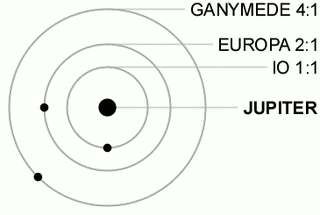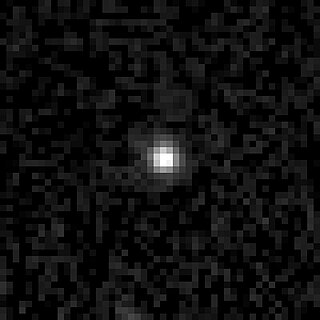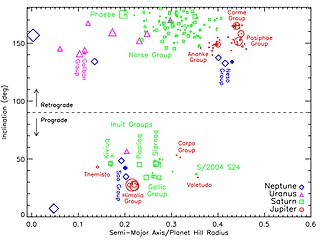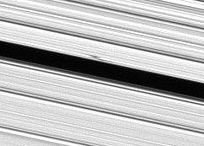
In celestial mechanics, orbital resonance occurs when orbiting bodies exert regular, periodic gravitational influence on each other, usually because their orbital periods are related by a ratio of small integers. Most commonly, this relationship is found between a pair of objects. The physical principle behind orbital resonance is similar in concept to pushing a child on a swing, whereby the orbit and the swing both have a natural frequency, and the body doing the "pushing" will act in periodic repetition to have a cumulative effect on the motion. Orbital resonances greatly enhance the mutual gravitational influence of the bodies. In most cases, this results in an unstable interaction, in which the bodies exchange momentum and shift orbits until the resonance no longer exists. Under some circumstances, a resonant system can be self-correcting and thus stable. Examples are the 1:2:4 resonance of Jupiter's moons Ganymede, Europa and Io, and the 2:3 resonance between Neptune and Pluto. Unstable resonances with Saturn's inner moons give rise to gaps in the rings of Saturn. The special case of 1:1 resonance between bodies with similar orbital radii causes large planetary system bodies to eject most other bodies sharing their orbits; this is part of the much more extensive process of clearing the neighbourhood, an effect that is used in the current definition of a planet.

A planet is a large, rounded astronomical body that is neither a star nor its remnant. The best available theory of planet formation is the nebular hypothesis, which posits that an interstellar cloud collapses out of a nebula to create a young protostar orbited by a protoplanetary disk. Planets grow in this disk by the gradual accumulation of material driven by gravity, a process called accretion. The Solar System has at least eight planets: the terrestrial planets Mercury, Venus, Earth, and Mars, and the giant planets Jupiter, Saturn, Uranus, and Neptune.

A ring system is a disc or ring, orbiting an astronomical object, that is composed of solid material such as dust and moonlets, and is a common component of satellite systems around giant planets like Saturn. A ring system around a planet is also known as a planetary ring system.

The Jupiter trojans, commonly called trojan asteroids or simply trojans, are a large group of asteroids that share the planet Jupiter's orbit around the Sun. Relative to Jupiter, each trojan librates around one of Jupiter's stable Lagrange points: either L4, existing 60° ahead of the planet in its orbit, or L5, 60° behind. Jupiter trojans are distributed in two elongated, curved regions around these Lagrangian points with an average semi-major axis of about 5.2 AU.

Amalthea is a moon of Jupiter. It has the third closest orbit around Jupiter among known moons and was the fifth moon of Jupiter to be discovered, so it is also known as Jupiter V. It is also the fifth largest moon of Jupiter, after the four Galilean Moons. Edward Emerson Barnard discovered the moon on 9 September 1892 and named it after Amalthea of Greek mythology. It was the last natural satellite to be discovered by direct visual observation; all later moons were discovered by photographic or digital imaging.

A natural satellite is, in the most common usage, an astronomical body that orbits a planet, dwarf planet, or small Solar System body. Natural satellites are colloquially referred to as moons, a derivation from the Moon of Earth.

Pan is the innermost named moon of Saturn. It is a small, ravioli-shaped moon approximately 35 kilometres across and 23 km wide that orbits within the Encke Gap in Saturn's A Ring. Pan is a ring shepherd and is responsible for keeping the Encke Gap free of ring particles. It is sometimes described as having the appearance of a walnut.

Himalia, or Jupiter VI, is the largest irregular satellite of Jupiter, with a diameter of at least 140 km (90 mi). It is the sixth largest Jovian satellite, after the four Galilean moons and Amalthea. It was discovered by Charles Dillon Perrine at the Lick Observatory on 3 December 1904 and is named after the nymph Himalia, who bore three sons of Zeus. It is one of the largest planetary moons in the Solar System not imaged in detail, and the third largest not imaged in detail within the orbit of Neptune.

There are 95 moons of Jupiter with confirmed orbits as of 5 February 2024. This number does not include a number of meter-sized moonlets thought to be shed from the inner moons, nor hundreds of possible kilometer-sized outer irregular moons that were only briefly captured by telescopes. All together, Jupiter's moons form a satellite system called the Jovian system. The most massive of the moons are the four Galilean moons: Io, Europa, Ganymede, and Callisto, which were independently discovered in 1610 by Galileo Galilei and Simon Marius and were the first objects found to orbit a body that was neither Earth nor the Sun. Much more recently, beginning in 1892, dozens of far smaller Jovian moons have been detected and have received the names of lovers or daughters of the Roman god Jupiter or his Greek equivalent Zeus. The Galilean moons are by far the largest and most massive objects to orbit Jupiter, with the remaining 91 known moons and the rings together composing just 0.003% of the total orbiting mass.

The moons of Saturn are numerous and diverse, ranging from tiny moonlets only tens of meters across to the enormous Titan, which is larger than the planet Mercury. There are 146 moons with confirmed orbits, the most of any planet in the solar system. This number does not include the many thousands of moonlets embedded within Saturn's dense rings, nor hundreds of possible kilometer-sized distant moons that were seen through telescopes but not recaptured. Seven Saturnian moons are large enough to have collapsed into a relaxed, ellipsoidal shape, though only one or two of those, Titan and possibly Rhea, are currently in hydrostatic equilibrium. Three moons are particularly notable. Titan is the second-largest moon in the Solar System, with a nitrogen-rich Earth-like atmosphere and a landscape featuring river networks and hydrocarbon lakes. Enceladus emits jets of ice from its south-polar region and is covered in a deep layer of snow. Iapetus has contrasting black and white hemispheres as well as an extensive ridge of equatorial mountains among the tallest in the solar system.

The planet Neptune has 16 known moons, which are named for minor water deities and a water creature in Greek mythology. By far the largest of them is Triton, discovered by William Lassell on October 10, 1846, 17 days after the discovery of Neptune itself. Over a century passed before the discovery of the second natural satellite, Nereid, in 1949, and another 40 years passed before Proteus, Neptune's second-largest moon, was discovered in 1989.

The rings of Saturn are the most extensive and complex ring system of any planet in the Solar System. They consist of countless small particles, ranging in size from micrometers to meters, that orbit around Saturn. The ring particles are made almost entirely of water ice, with a trace component of rocky material. There is still no consensus as to their mechanism of formation. Although theoretical models indicated that the rings were likely to have formed early in the Solar System's history, newer data from Cassini suggested they formed relatively late.

The planet Jupiter has a system of faint planetary rings. The Jovian rings were the third ring system to be discovered in the Solar System, after those of Saturn and Uranus. The main ring was discovered in 1979 by the Voyager 1 space probe and the system was more thoroughly investigated in the 1990s by the Galileo orbiter. The main ring has also been observed by the Hubble Space Telescope and from Earth for several years. Ground-based observation of the rings requires the largest available telescopes.

10199 Chariklo is the largest confirmed centaur. It orbits the Sun between Saturn and Uranus, grazing the orbit of Uranus. On 26 March 2014, astronomers announced the discovery of two rings around Chariklo by observing a stellar occultation, making it the first minor planet known to have rings.

In astronomy, an irregular moon, irregular satellite, or irregular natural satellite is a natural satellite following a distant, inclined, and often highly elliptical and retrograde orbit. They have been captured by their parent planet, unlike regular satellites, which formed in orbit around them. Irregular moons have a stable orbit, unlike temporary satellites which often have similarly irregular orbits but will eventually depart. The term does not refer to shape; Triton, for example, is a round moon but is considered irregular due to its orbit and origins.
In astronomy, an inner moon or inner natural satellite is a natural satellite following a prograde, low-inclination orbit inwards of the large satellites of the parent planet. They are generally thought to have been formed in situ at the same time as the coalescence of the original planet. Neptune's moons are an exception, as they are likely reaggregates of the pieces of the original bodies, which were disrupted after the capture of the large moon Triton. Inner satellites are distinguished from other regular satellites by their proximity to the parent planet, their short orbital periods, their low mass, small size, and irregular shapes.

In astronomy, a regular moon or a regular satellite is a natural satellite following a relatively close, stable, and circular orbit which is generally aligned to its primary's equator. They form within discs of debris and gas that once surrounded their primary, usually the aftermath of a large collision or leftover material accumulated from the protoplanetary disc. Young regular moons then begin to accumulate material within the circumplanetary disc in a process similar to planetary accretion, as opposed to irregular moons, which formed independently before being captured into orbit around the primary.

A satellite system is a set of gravitationally bound objects in orbit around a planetary mass object or minor planet, or its barycenter. Generally speaking, it is a set of natural satellites (moons), although such systems may also consist of bodies such as circumplanetary disks, ring systems, moonlets, minor-planet moons and artificial satellites any of which may themselves have satellite systems of their own. Some bodies also possess quasi-satellites that have orbits gravitationally influenced by their primary, but are generally not considered to be part of a satellite system. Satellite systems can have complex interactions including magnetic, tidal, atmospheric and orbital interactions such as orbital resonances and libration. Individually major satellite objects are designated in Roman numerals. Satellite systems are referred to either by the possessive adjectives of their primary, or less commonly by the name of their primary. Where only one satellite is known, or it is a binary with a common centre of gravity, it may be referred to using the hyphenated names of the primary and major satellite.





















